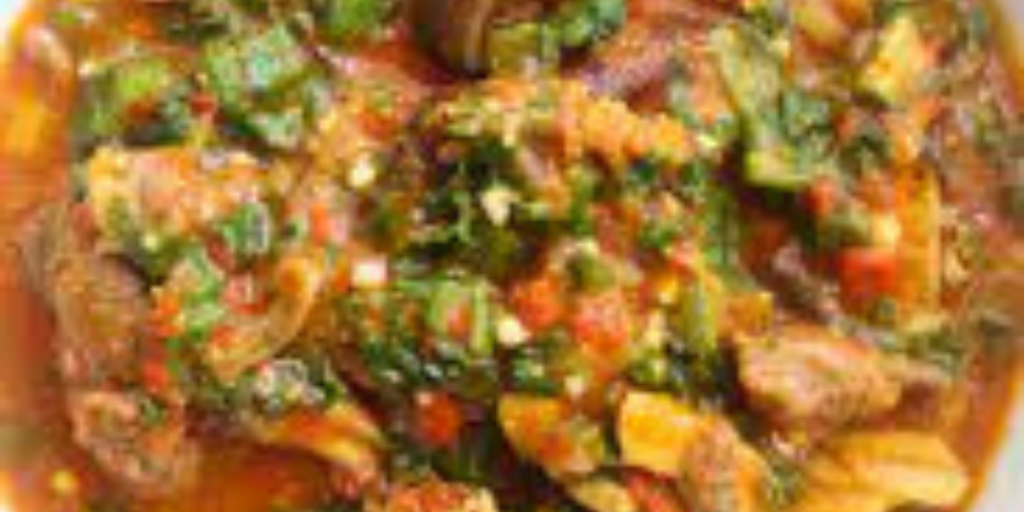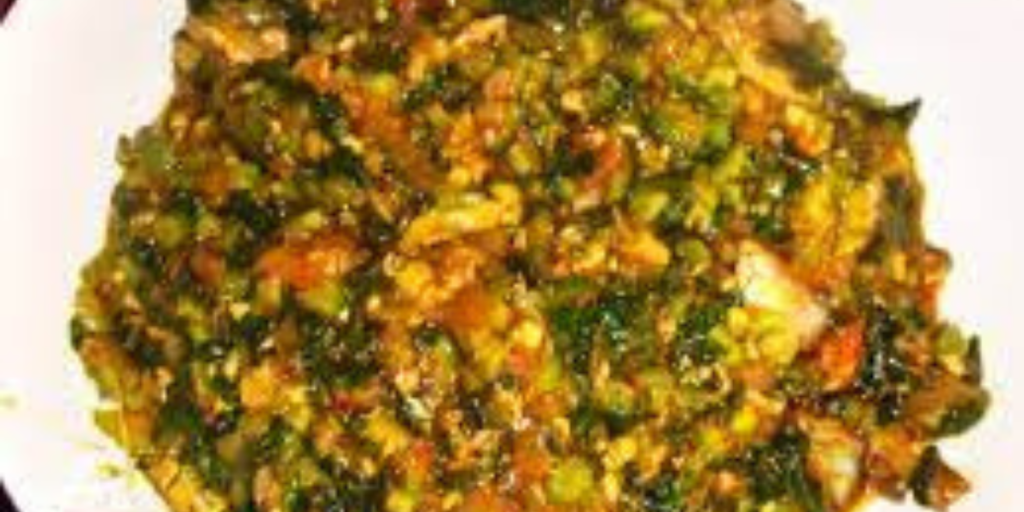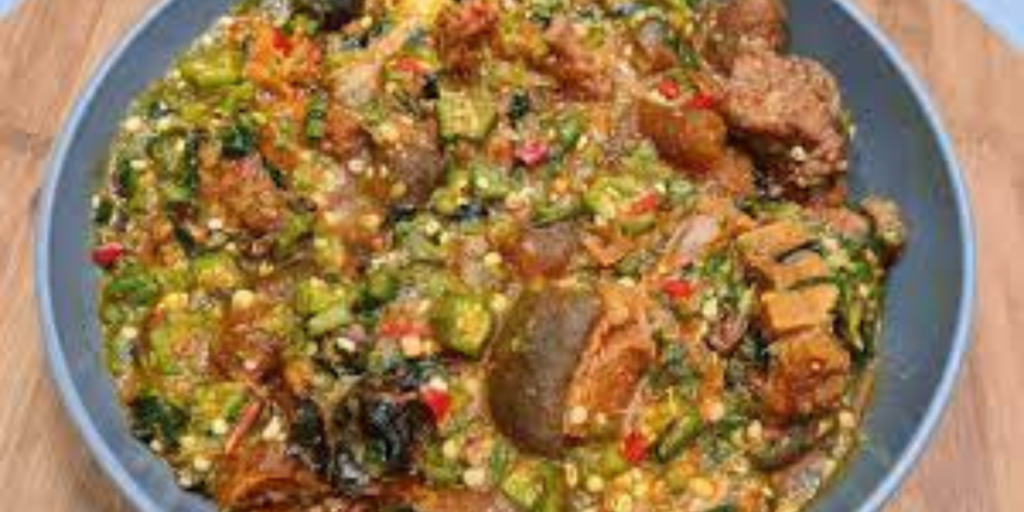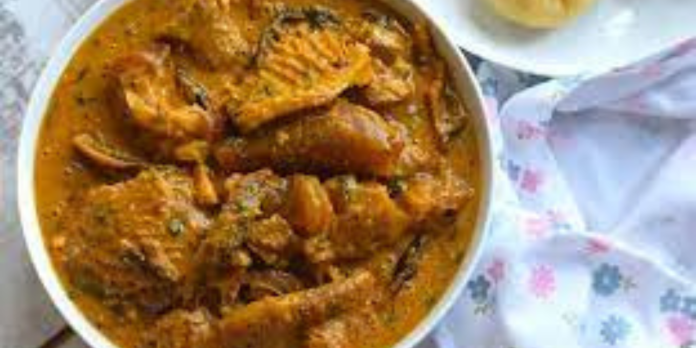Table of Contents
how to cook ogbono soup : Ogbono soup is a staple in Nigerian cuisine, beloved for its thick, rich consistency and its ability to cling to various swallows like pounded yam, fufu, or eba. The soup, made from ground ogbono seeds, also known as African wild mango seeds, is not just a culinary delight but also a nutrient-dense dish. Adding bitter leaf to ogbono soup introduces a slightly bitter yet refreshing contrast that elevates the flavor profile, creating a perfect balance. In this comprehensive guide, we will delve deeply into how to cook ogbono soup with bitter leaf, offering a step-by-step process, tips, variations, and much more.
Introduction to Ogbono Soup (how to cook ogbono soup)

Ogbono soup is one of the most cherished dishes in Nigerian homes, particularly among the Igbo, Yoruba, and Edo people. Known for its mucilaginous texture, this soup is made primarily from ground ogbono seeds, which are rich in essential fatty acids and dietary fiber. The unique feature of ogbono soup is its ability to thicken and become slimy when cooked, a texture that is highly prized in Nigerian cuisine. Bitter leaf, which is often added to this dish, provides a slightly bitter undertone that complements the rich, savory flavor of the soup.
Ogbono seeds, also known as wild mango or bush mango seeds, are derived from the Irvingia gabonensis tree, which is native to West and Central Africa. These seeds have been used for centuries in traditional medicine and cuisine, not just for their flavor but also for their health benefits. Bitter leaf, scientifically known as Vernonia amygdalina, is another traditional ingredient widely used in African cooking for its nutritional properties and its ability to add a unique flavor to soups and stews.
In this guide, we will walk you through the entire process of preparing ogbono soup with bitter leaf, from selecting the ingredients to serving the finished dish. Whether you’re a novice cook or an experienced chef, this guide will provide you with all the information you need to create a delicious and nutritious meal.
(how to cook ogbono soup)
Ogbono Soup Recipe Easy | Best Ogbono soup recipe 2024
The Cultural Significance of Ogbono Soup(how to cook ogbono soup)
Ogbono soup holds a special place in the culinary traditions of many Nigerian ethnic groups. Among the Igbo people, for example, ogbono soup is often prepared during special occasions, such as weddings, festivals, and family gatherings. The soup is also a common dish during the rainy season, when its warming, hearty nature is especially appreciated.
In Yoruba culture, ogbono soup is often served as a comfort food, offering warmth and sustenance during cold or rainy days. The soup is also believed to have health benefits, particularly for digestion, which makes it a popular choice for those recovering from illness.
The Edo people, who are known for their diverse and flavorful cuisine, also have their own variations of ogbono soup. In Edo State, ogbono is sometimes combined with other seeds and leaves to create a complex, layered dish that reflects the rich culinary heritage of the region.
In many Nigerian households, the preparation of ogbono soup is a communal activity, with family members coming together to cook and share the meal. The soup is often served with a variety of swallows, such as pounded yam, fufu, or eba, which are used to scoop up the thick, flavorful soup. This communal aspect of eating ogbono soup reflects the importance of food in bringing people together and strengthening social bonds.
(how to cook ogbono soup)
Health Benefits of Ogbono and Bitter Leaf(how to cook ogbono soup)
Ogbono seeds are more than just a flavorful ingredient; they are packed with essential nutrients that contribute to overall health. These seeds are high in healthy fats, particularly omega-3 fatty acids, which are known for their heart-protective properties. They also contain dietary fiber, which aids in digestion and helps to maintain healthy blood sugar levels. Additionally, ogbono seeds are a good source of calcium, magnesium, and potassium, minerals that are vital for bone health and the proper functioning of the cardiovascular system.
Bitter leaf is another powerhouse ingredient with numerous health benefits. It is rich in vitamins A, C, and E, which are important antioxidants that help protect the body from oxidative stress and boost the immune system. Bitter leaf also contains a variety of bioactive compounds that have anti-inflammatory, antibacterial, and antifungal properties. These compounds make bitter leaf an important ingredient in traditional medicine, where it is used to treat a range of ailments, including malaria, diabetes, and gastrointestinal issues.
When combined in ogbono soup, these two ingredients create a dish that is not only delicious but also highly nutritious. The healthy fats in ogbono seeds help to improve cholesterol levels and support brain health, while the antioxidants in bitter leaf protect the body from chronic diseases. Together, they provide a balanced meal that nourishes the body and satisfies the palate.
(how to cook ogbono soup)
Best Ogbono Soup Recipe Without Uziza In 2024
Ingredients for Ogbono Soup with Bitter Leaf(how to cook ogbono soup)
To prepare ogbono soup with bitter leaf, you will need the following ingredients:
- Ogbono seeds (1 cup, ground)
- Bitter leaf (a handful, washed thoroughly to remove excess bitterness)
- Palm oil (2-3 tablespoons)
- Meat or fish (beef, goat meat, chicken, or fish, depending on your preference)
- Stockfish (optional, soaked and shredded)
- Crayfish (2 tablespoons, ground)
- Dry fish (1 medium, cleaned and shredded)
- Uziza seeds (1 teaspoon, ground, optional for extra flavor)
- Pepper (to taste, either fresh or dried)
- Onions (1 medium-sized, chopped)
- Seasoning cubes (2-3, to taste)
- Salt (to taste)
- Water or meat stock (as needed)
These ingredients can be easily sourced from local markets or specialty stores that sell African food products. When selecting the ingredients, it’s important to choose fresh, high-quality items to ensure the best flavor and nutritional value.
(how to cook ogbono soup)
Step-by-Step Guide on How to Cook Ogbono Soup with Bitter Leaf(how to cook ogbono soup)

Now that you have all your ingredients ready, let’s dive into the cooking process. Follow these steps carefully to create a delicious and satisfying ogbono soup with bitter leaf.
Step 1: Preparing the Ingredients
- Ogbono Seeds: Start by grinding the ogbono seeds into a fine powder using a dry mill or a mortar and pestle. Ensure that the seeds are finely ground to avoid lumps in your soup. If you don’t have access to a grinder, you can purchase pre-ground ogbono from a trusted source, but freshly ground seeds are always preferred for their stronger flavor.
- (how to cook ogbono soup)
- Bitter Leaf: Wash the bitter leaf thoroughly to reduce its bitterness. This can be done by washing and squeezing the leaves several times in clean water until most of the bitterness is gone. The washing process can be time-consuming, but it’s an essential step to ensure the right balance of flavors in your soup. After washing, set the leaves aside in a colander to drain.
- Meat or Fish: If you’re using meat, cut it into bite-sized pieces. Season with salt and seasoning cubes, and cook until tender. If you’re using fish, clean it thoroughly and cut it into desired portions. For added flavor, you can also marinate the meat or fish for a few hours before cooking.
- Stockfish and Dry Fish: Soak the stockfish in hot water to soften it, then shred it into small pieces. Clean the dry fish, remove the bones, and shred it as well. These fish options add a depth of flavor to the soup and contribute to its overall richness.
- Uziza Seeds: If you decide to add uziza seeds for an extra kick, grind them into a fine powder. Uziza adds a slightly peppery and aromatic flavor to the soup, enhancing its complexity.
Step 2: Cooking the Meat
- Season and Cook: In a pot, add your choice of meat (beef, goat meat, or chicken), onions, seasoning cubes, and a pinch of salt. Add enough water to cover the meat and bring it to a boil. Cooking the meat with onions and seasoning ensures that the flavors penetrate deeply, resulting in a more flavorful soup.
- Simmer: Reduce the heat to low and let the meat cook until it’s tender. This process usually takes about 30-45 minutes, depending on the type of meat you’re using. Tender meat is crucial for a pleasant eating experience, so be patient during this step.
- Set Aside: Once the meat is cooked, remove it from the pot and set it aside. Reserve the meat stock as it will be used later in the cooking process. The meat stock is a flavorful base that contributes to the richness of the soup.
Step 3: Preparing the Ogbono Soup Base
- Heat Palm Oil: In a separate pot, heat the palm oil over medium heat. Be careful not to let the oil overheat or smoke, as this can alter the taste of the soup. Heating the oil properly ensures that it blends smoothly with the ogbono powder.
- Add Ogbono: Once the palm oil is hot, add the ground ogbono powder. Stir continuously to prevent the ogbono from clumping. The ogbono will dissolve into the palm oil, forming a thick, smooth mixture. This step is crucial for achieving the characteristic slimy texture of ogbono soup.
- Cook the Ogbono: Allow the ogbono mixture to cook for about 5-10 minutes, stirring frequently. The mixture should start to thicken and become glossy. At this point, you can add a small amount of meat stock or water to adjust the consistency of the soup. Cooking the ogbono thoroughly ensures that it fully absorbs the flavors of the soup.
Step 4: Combining the Ingredients
- Add Meat and Stockfish: Once the ogbono base is ready, add the cooked meat, shredded stockfish, and dry fish to the pot. Stir to combine all the ingredients, ensuring that the meat and fish are evenly coated with the ogbono mixture. This step integrates the flavors of the meat and fish into the soup.
- Season: Add ground crayfish, ground uziza seeds (if using), and pepper to the soup. Stir well to incorporate the spices evenly. The crayfish and uziza seeds add depth and a slightly spicy note to the soup, enhancing its overall flavor profile.
- Simmer: Reduce the heat to low and let the soup simmer for about 10-15 minutes. This allows the flavors to meld together, creating a rich and savory soup. During this time, you can adjust the thickness of the soup by adding more stock or water if needed.
Step 5: Adding the Bitter Leaf
- Add Bitter Leaf: Finally, add the washed bitter leaf to the soup. Stir well to combine the bitter leaf with the ogbono mixture. The bitter leaf should be added towards the end of the cooking process to preserve its slightly bitter flavor and crunchy texture.
- Cook for a Few Minutes: Allow the soup to cook for an additional 5-10 minutes, just enough time for the bitter leaf to soften slightly and release its flavors into the soup. Be careful not to overcook the bitter leaf, as this can make it too soft and reduce its flavor.
Step 6: Final Seasoning and Serving
- Taste and Adjust: Before serving, taste the soup and adjust the seasoning if necessary. You may need to add a bit more salt or seasoning cubes, depending on your preference. Proper seasoning is key to bringing out the full range of flavors in the soup.
- Serve: Ogbono soup with bitter leaf is best enjoyed with a side of your favorite swallow, such as pounded yam, eba, or fufu. Serve the soup hot, and enjoy the delicious combination of flavors and textures. The thick, slimy consistency of the soup pairs perfectly with the starchy swallows, creating a satisfying meal.
- (how to cook ogbono soup)
Tips for Cooking the Perfect Ogbono Soup(how to cook ogbono soup)

Cooking the perfect ogbono soup requires a combination of the right techniques and attention to detail. Here are some tips to help you achieve the best results:
- Use Fresh Ingredients: Fresh ogbono seeds and bitter leaf will give your soup a more vibrant flavor. Avoid using pre-packaged or expired ingredients, as they may lack the necessary flavor and nutrients.
- Control the Sliminess: If you prefer a less slimy soup, you can reduce the amount of ogbono used or cook the ogbono mixture for a longer time before adding the meat and other ingredients. Conversely, if you want a thicker, slimier soup, use a bit more ogbono and cook it for a shorter time.
- Balance the Bitterness: The bitterness of the bitter leaf can be adjusted according to your taste. If you prefer a milder flavor, wash the bitter leaf more thoroughly or blanch it in hot water before adding it to the soup.
- Don’t Overcook the Bitter Leaf: Overcooking the bitter leaf can cause it to lose its crunch and become too soft. Add it towards the end of the cooking process to maintain its texture and flavor.
- Experiment with Spices: While traditional ogbono soup recipes use crayfish, pepper, and sometimes uziza seeds, don’t be afraid to experiment with other spices and herbs to create your unique version of the soup.
Common Mistakes to Avoid(how to cook ogbono soup)
Even experienced cooks can make mistakes when preparing ogbono soup. Here are some common pitfalls to watch out for:
- Skipping the Washing of Bitter Leaf: Failing to wash the bitter leaf thoroughly can result in an overly bitter soup. Always take the time to wash and squeeze the leaves properly before adding them to the soup.
- Not Dissolving the Ogbono Properly: If the ogbono seeds are not ground finely or are not dissolved properly in the palm oil, the soup may have lumps. Make sure to stir the ogbono continuously while cooking to avoid this issue.
- Overcooking the Meat: Overcooked meat can become tough and dry, detracting from the overall texture of the soup. Cook the meat until just tender, and avoid boiling it for too long.
- Adding Too Much Water: Adding too much water to the soup can dilute the flavors and make the soup too runny. Start with a small amount of water or stock, and gradually add more as needed to achieve the desired consistency.
- Neglecting to Season the Soup: Proper seasoning is essential for a flavorful soup. Taste the soup as you cook and adjust the seasoning accordingly to ensure a well-balanced dish.
Variations of Ogbono Soup(how to cook ogbono soup)

Ogbono soup is a versatile dish that can be customized to suit different tastes and dietary preferences. Here are some popular variations:
- Ogbono Soup with Okra: Adding okra to ogbono soup enhances its slimy texture and adds a fresh, green flavor. Okra is a common addition that complements the ogbono seeds and provides extra nutrients.
- Ogbono Soup with Spinach: For a milder flavor, spinach can be used in place of bitter leaf. Spinach is softer and less bitter, making it a good option for those who prefer a less intense flavor.
- Ogbono Soup with Egusi: Combining ogbono and egusi (melon seeds) creates a thicker, richer soup with a nutty flavor. This variation is popular among those who enjoy the distinct taste of egusi soup.
- Vegetarian Ogbono Soup: For a vegetarian version, omit the meat and fish and use vegetable stock instead. You can add mushrooms, tofu, or other plant-based proteins to create a hearty, satisfying soup.
- Seafood Ogbono Soup: Replace the meat with a variety of seafood, such as shrimp, crab, and fish, to create a seafood-inspired ogbono soup. This variation is especially popular in coastal regions.
Serving Suggestions for Ogbono Soup(how to cook ogbono soup)
Ogbono soup is traditionally served with a variety of swallows, which are starchy side dishes used to scoop up the soup. Here are some popular options:
- Pounded Yam: Made from boiled and pounded yam tubers, this is a classic pairing for ogbono soup. Its smooth, doughy texture complements the slimy consistency of the soup.
- Eba: Also known as garri, eba is made from cassava flour and has a slightly grainy texture. It’s a popular and affordable option for serving with ogbono soup.
- Fufu: Fufu can be made from different starchy vegetables, such as plantains, yams, or cassava. Its soft, elastic texture makes it an ideal accompaniment to ogbono soup.
- Amala: Made from yam flour, amala has a slightly sour taste and a dark color. It’s a favorite in Yoruba cuisine and pairs well with the rich flavors of ogbono soup.
- Semolina: Semolina, made from wheat, is another common swallow that is smooth and easy to prepare. It’s a lighter option for those who prefer a less dense accompaniment.
In addition to swallows, ogbono soup can also be served with boiled rice or yam for a different take on the traditional meal.
how to cook ogbono soup
Nutritional Analysis of Ogbono Soup(how to cook ogbono soup)

Ogbono soup is not only delicious but also packed with essential nutrients. Here’s a breakdown of the nutritional content of a typical serving of ogbono soup with bitter leaf:
- Calories: A standard serving of ogbono soup provides approximately 250-350 calories, depending on the specific ingredients used.
- Protein: The meat, fish, and crayfish in the soup contribute to a high protein content, providing around 15-25 grams per serving.
- Fats: Ogbono seeds are rich in healthy fats, particularly omega-3 fatty acids. A serving of ogbono soup can provide 15-20 grams of fat, with the majority being heart-healthy fats.
- Carbohydrates: The soup itself is low in carbohydrates, but when served with swallows like pounded yam or eba, the carbohydrate content increases significantly.
- Fiber: Ogbono seeds and bitter leaf are good sources of dietary fiber, aiding in digestion and promoting a healthy gut. A serving of the soup can provide 4-6 grams of fiber.
- Vitamins and Minerals: Ogbono soup is rich in vitamins A and C from the bitter leaf, as well as calcium, iron, and magnesium from the seeds and fish. These nutrients are essential for maintaining overall health.
Health Benefits of Ogbono Soup(how to cook ogbono soup)
Ogbono soup offers several health benefits, making it a nutritious addition to your diet. Here are some of the key benefits:
- Supports Heart Health: The omega-3 fatty acids in ogbono seeds help reduce inflammation and lower the risk of heart disease. These healthy fats also promote good cholesterol levels.
- Aids Digestion: The high fiber content in ogbono soup supports healthy digestion by preventing constipation and promoting regular bowel movements.
- Boosts Immunity: The vitamins and antioxidants in bitter leaf and other ingredients help strengthen the immune system, protecting against illnesses and infections.
- Promotes Weight Management: Ogbono soup is relatively low in calories and high in protein and fiber, making it a filling meal that can aid in weight management. The soup helps keep you full for longer, reducing the likelihood of overeating.
- Supports Bone Health: The calcium and magnesium in ogbono seeds and bitter leaf contribute to strong bones and teeth. Regular consumption of ogbono soup can help prevent osteoporosis and other bone-related conditions.
Frequently Asked Questions About Ogbono Soup(how to cook ogbono soup)

Q: Can I use frozen ogbono seeds?
A: Yes, frozen ogbono seeds can be used to make ogbono soup. Just make sure to thaw them completely before grinding and adding them to the soup.
Q: How do I store leftover ogbono soup?
A: Leftover ogbono soup can be stored in an airtight container in the refrigerator for up to 3 days. Reheat it gently on the stove or in the microwave, adding a little water if needed to adjust the consistency.
Q: Can I make ogbono soup without palm oil?
A: While palm oil is traditional in ogbono soup, you can substitute it with other oils, such as vegetable or olive oil, if you prefer. However, this will alter the flavor and color of the soup.
Q: Is ogbono soup suitable for vegetarians?
A: Yes, ogbono soup can be made vegetarian by omitting the meat and fish and using vegetable stock. You can also add plant-based proteins, such as mushrooms or tofu, for a heartier dish.
Q: Can I freeze ogbono soup?
A: Yes, ogbono soup freezes well. Store it in a freezer-safe container for up to 2 months. Thaw it in the refrigerator overnight before reheating.
Q: What can I use instead of bitter leaf?
A: If bitter leaf is not available, you can use spinach, kale, or any other leafy green as a substitute. Each will impart a slightly different flavor to the soup.
Q: Can I add vegetables to ogbono soup?
A: Yes, vegetables like okra, pumpkin leaves, or spinach can be added to ogbono soup for extra nutrients and flavor.
how to cook ogbono soup
Ogbono soup with bitter leaf is a beloved Nigerian dish that offers a delightful combination of flavors, textures, and nutritional benefits. With its rich, slimy consistency and slightly bitter undertones, it’s a unique dish that stands out in Nigerian cuisine. Whether you’re a seasoned cook or new to Nigerian cooking, this guide provides all the information you need to make a delicious pot of ogbono soup at home. By following the steps outlined above and experimenting with different variations, you can create a dish that suits your taste preferences and dietary needs. Serve it with your favorite swallow and enjoy a meal that is both satisfying and nutritious.
how to cook ogbono soup : Ogbono soup is more than just a meal; it’s a culinary experience that connects you to the rich traditions and culture of Nigeria. As you savor each bite, you’ll appreciate the care and attention that goes into preparing this classic dish. Whether enjoyed on a special occasion or as a comforting weeknight dinner, ogbono soup with bitter leaf is sure to become a favorite in your household.






















Thank you for your sharing. I am worried that I lack creative ideas. It is your article that makes me full of hope. Thank you. But, I have a question, can you help me?